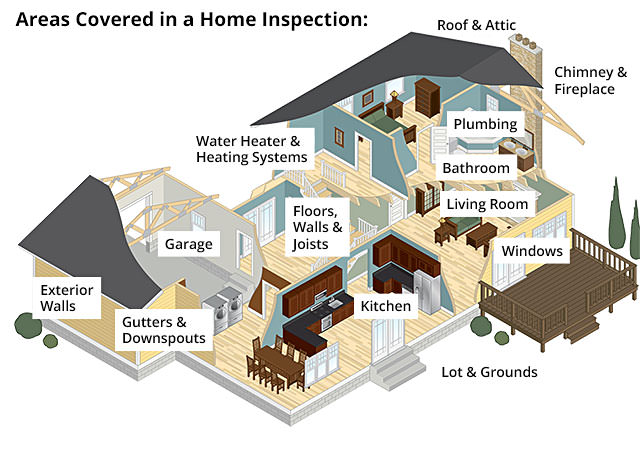Commercial property inspections to identify risks and ensure regulatory compliance
Commercial property inspections to identify risks and ensure regulatory compliance
Blog Article
What Is Consisted of in a Comprehensive Residential Property Examination Process?
A thorough property evaluation procedure is important for protecting financial investments and making sure security. It encompasses a careful examination of architectural stability, electric systems, plumbing, and heating and cooling systems, to name a few important elements. Examiners do an extensive exam of both outside and interior aspects, identifying potential dangers and compliance with industry standards. The resulting record functions as an important source for current proprietors and potential purchasers alike. Nonetheless, the specifics of what examiners prioritize, and the effects of their searchings for, can substantially influence decision-making. What, then, are one of the most essential facets that can make or damage a residential property evaluation?
Summary of Building Inspection

The assessment encompasses a number of key locations, including the exterior and indoor aspects, systems such as plumbing and electric, and any kind of visible architectural components (Best home inspections). During the procedure, the inspector records the problem of these elements, trying to find signs of wear, damage, or potential threats
A comprehensive residential or commercial property inspection not just aids potential purchasers make educated decisions but additionally assists existing proprietors in comprehending needed repair services or upkeep tasks. By giving an in-depth record of findings, the evaluation enables stakeholders to focus on concerns that might call for instant attention or can impact future financial investment.
Additionally, a reliable assessment procedure sticks to developed sector requirements and guidelines, ensuring a regular and trusted assessment. On the whole, the building inspection procedure is an essential tool in property transactions, promoting transparency and safeguarding both customer and seller rate of interests.
Structural Assessment

During the assessment, experts evaluate different components, including the foundation, framing, wall surfaces, and roofing systems. They seek signs of moving or working out, such as fractures in walls or irregular floors, which can indicate underlying concerns. The analysis additionally involves examining the high quality of building materials and methods used, guaranteeing compliance with building ordinance and requirements.
Additionally, examiners might look for signs of wetness breach, which can bring about timber rot and mold and mildew, additional compromising structural stability. They likewise examine load-bearing components to ensure they can appropriately support the weight of the building and its components.
Ultimately, a complete structural examination supplies vital insights for potential purchasers and property owners, allowing them to make enlightened decisions concerning building investments and required upkeep. By recognizing structural problems early, owners can attend to issues proactively, maintaining the long-term worth and safety and security of the residential or commercial property.
Electrical System Evaluation
An efficient electrical system analysis is important in the residential or commercial property assessment procedure, as it examines the safety and security, performance, and compliance of a structure's electrical infrastructure - Best home inspections. This assessment normally encompasses an extensive assessment of the primary electrical panel, circuit breakers, and circuitry systems. Inspectors look for signs of wear, rust, or damage that may endanger safety and security
The evaluation includes screening for appropriate grounding and bonding, guaranteeing that the electrical system is appropriately attached to avoid electric shock or fire risks. Inspectors also examine the capacity of the electric system to manage the existing tons, identifying any type of potential straining issues that could bring about outages or failures.
Furthermore, the analysis checks for the visibility of GFCI (Ground Mistake Circuit Interrupter) and AFCI (Arc Fault Circuit image source Interrupter) devices in ideal areas, which are important for safeguarding versus electric shocks and protecting against fires. Conformity with regional building regulations and regulations is additionally verified to ensure that any setups or alterations satisfy security requirements.

Pipes and Cooling And Heating Checks
Following the electric system assessment, the plumbing and HVAC checks are indispensable elements of the residential property assessment process. These assessments guarantee that the crucial systems of the residential or commercial property are operating correctly and safely, thereby safeguarding the financial investment and health of the occupants.
Throughout pipes assessments, specialists assess the condition of pipes, fixtures, and drainage systems. They look for leakages, rust, and any type of indications of water damage that might indicate larger issues. The effectiveness of water heating units is also reviewed to ensure they meet existing requirements and give adequate warm water supply.
The heating and cooling checks involve a complete examination of air flow, air, and heating conditioning systems. Assessors will assess the functional performance of these systems, ensuring that they keep a comfortable indoor atmosphere. This consists of inspecting the heating system, air ductwork, conditioner, and thermostat performance. Furthermore, the assessor will seek any kind of signs of wear or possible safety and security threats, such as carbon monoxide gas leakages in heating unit.
Exterior and Interior Examinations
Outside and interior assessments are essential aspects of the home assessment procedure, providing a detailed overview of a property's condition. The external inspection involves assessing architectural elements such as the roof covering, siding, foundation, and home windows. Inspectors search for signs of wear, damages, or potential risks, consisting of water intrusion, mold growth, and insect invasions. They likewise assess the surrounding landscape, making certain appropriate drainage and determining any kind of trees or plant life that may endanger the home.
The indoor assessment focuses on the problem of living rooms, including walls, flooring, and ceilings. Assessors check out the functionality of doors, windows, and devices, while also inspecting for signs of moisture image source or architectural problems. Electric systems, plumbing fixtures, and HVAC devices are inspected to ensure they are in functioning order, certified with structure codes, and devoid of safety and security dangers.
Both assessments culminate in a thorough report that highlights vital findings and referrals for repairs or more examinations. This dual technique ensures that potential customers or proprietors are totally notified concerning the residential property's toughness and weaknesses, enabling them to make educated choices.
Conclusion
In conclusion, a comprehensive home assessment process incorporates a substantial assessment of structural honesty, electric systems, pipes, and a/c devices, along with detailed exterior and indoor evaluations - Best home inspections. By systematically analyzing each crucial element, prospective security hazards and conformity with sector standards and local building ordinance can be determined. The resultant comprehensive report acts as an essential resource, empowering property owners and customers to make educated decisions concerning property financial investments and upkeep, eventually enhancing safety and security and worth
A comprehensive building evaluation process is essential for protecting financial investments and making sure safety.Throughout the evaluation, experts analyze different parts, including the structure, framework, wall surfaces, and roofing systems.A reliable electrical system analysis is essential in the building assessment procedure, as it assesses the security, performance, and conformity of a structure's electrical framework.Exterior and indoor assessments are important aspects of the home assessment process, providing a thorough introduction of a property's problem.In conclusion, a thorough building evaluation procedure encompasses an extensive examination of architectural stability, electrical systems, pipes, and navigate to this website Heating and cooling devices, along with comprehensive exterior and interior examinations.
Report this page